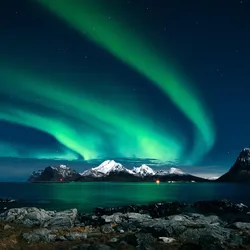
Level 1:
The Arctic is a place where it’s very cold and hard for people to live. Scientists go there to learn new things about the ice, snow, and the animals that live there. They want to know how the weather is changing and what will happen in the future. But, it’s dangerous because the weather can change quickly. For example, it can start to snow heavily and make it hard to see where you’re going. Or, strong winds can blow things around and make it uncomfortable to stay outside. There aren’t many big buildings and roads in the Arctic, which makes it hard for scientists to bring all their things. The ground is not safe because the ice is melting. That’s why they have to be careful when walking or building things. However, scientists still work hard to learn new things. Sometimes, they use small machines called drones to help them!
Level 2:
The Arctic region presents significant challenges to researchers and scientists due to its hostile environment. The unpredictable weather conditions, such as extreme cold temperatures, blizzards, and high winds, make it difficult to conduct research safely and effectively. In addition, the limited infrastructure available for conducting scientific research in the Arctic, along with its remoteness, adds to the difficulty of maintaining equipment and supplies. The melting permafrost also affects the stability of buildings and other structures, posing significant safety risks for researchers and their equipment. Despite these challenges, scientists continue to work tirelessly to collect data and understand the effects of climate change on this vital region. They use specialized equipment, such as icebreakers and drones, to reach remote research sites and gather data on sea ice thickness, ocean temperatures, and marine life.
Full Story:
The Arctic region is experiencing significant changes that are causing concern for scientists in Norway. The area is warming at an alarming rate, and the effects of this warming are being felt across the region. The Svalbard islands, in particular, are experiencing temperatures that are climbing up to seven times quicker than in other parts of the world.
This rapid warming is having a profound impact on the Arctic’s environment. Sea ice is melting, causing rising sea levels and damaging buildings built on permafrost. Animals like polar bears are also changing their behavior, adapting to new hunting areas, and struggling to find food as their natural habitat changes.
Despite these challenges, scientists in Norway are working hard to understand the impact of these changes and how they will affect the planet’s future. They face a race against time to gather data before the Arctic environment changes beyond recognition.
The Norwegian research station is home to a team of scientists studying the Arctic region. They use advanced technology to measure temperature, air quality, and sea ice levels. Their work is critical to understanding how the Arctic is changing and what can be done to mitigate its impact on the planet.
One of the most significant challenges facing scientists in the Arctic is the rapid pace of change. The region is changing faster than anywhere else on Earth, making it difficult to predict long-term outcomes. For example, the melting of sea ice is leading to rising sea levels, which could have far-reaching consequences for coastal communities worldwide.
The Arctic region is a hostile environment that presents significant challenges to researchers and scientists. In recent years, the accessibility of research sites in the Arctic has become increasingly difficult due to climate change and its impact on the environment.
One of the most significant challenges facing researchers in the Arctic is the unpredictability of climate conditions. The harsh weather conditions in the Arctic can change rapidly and unexpectedly, making it challenging to conduct research safely and effectively. Extreme cold temperatures, blizzards, and high winds are just some of the hazards that researchers must navigate daily.
Another challenge researchers face is the limited infrastructure available for conducting scientific research in the Arctic. Unlike other parts of the world, the Arctic region lacks the necessary infrastructure to support large-scale scientific projects. Researchers often have to rely on small, specialized teams, and equipment and supplies must be transported from far away, which can be costly and time-consuming.
Moreover, the infrastructure needed to conduct research in the Arctic is also affected by climate change. As the permafrost melts, the ground becomes unstable, affecting the stability of buildings and other structures. It also makes transportation challenging, as roads and runways built on permafrost become unstable, posing significant safety risks for researchers and their equipment.
The remoteness of the Arctic region also poses challenges for researchers. Many research sites in the Arctic are located far from populated areas, and transportation to these sites can be difficult and expensive. This remoteness makes it challenging to maintain equipment and supplies, leading to higher costs and delays in research projects.
Despite these challenges, researchers in the Arctic continue to work tirelessly to collect data and understand the effects of climate change on the region. They use specialized equipment, such as icebreakers, to reach remote research sites and collect data on sea ice thickness, ocean temperatures, and marine life.
The development of new technologies and techniques has also helped researchers overcome some of the challenges of conducting research in the Arctic. For example, researchers are now using drones to survey large areas of the Arctic quickly and safely, allowing them to gather data without risking human life.
Despite these difficulties, scientists in Norway are making progress in understanding the impact of Arctic warming. They are using cutting-edge technology to collect data and collaborating with other experts around the world to share knowledge and findings.
One of the key areas of research for scientists in Norway is the impact of Arctic warming on marine life. As sea ice melts, it’s changing the chemistry of the ocean, making it more acidic. This change is having a profound impact on the creatures that live in the Arctic waters, from tiny plankton to larger animals like whales and seals.
In addition to studying the impact of Arctic warming on marine life, scientists in Norway are also investigating its effect on land-based ecosystems. They are studying how melting permafrost is affecting soil quality and plant life, as well as the impact on animal habitats and migration patterns.
As the Arctic region continues to warm at an alarming rate, scientists in Norway are working hard to understand the changes and their impact on the planet. Their work is vital to developing strategies to mitigate the impact of climate change and protect our planet’s future.
Questions:
What are some of the challenges that researchers face when conducting scientific research in the Arctic region?
How does climate change affect infrastructure and equipment used in Arctic research?
Why is it essential to understand the impact of climate change on the Arctic region?
In what ways have new technologies and techniques helped researchers overcome some of the challenges of conducting research in the Arctic?
Do you believe that enough is being done to address the impact of climate change on the Arctic region?
Fill in the Blanks:
unpredictability, challenging, permafrost, remote, hostile
Sea ice is melting, causing rising sea levels and damaging buildings built on ________.
The Arctic region is a ________ environment that presents significant challenges to researchers and scientists.
One of the most significant challenges facing researchers in the Arctic is the ________ of climate conditions.
The harsh weather conditions in the Arctic can change rapidly and unexpectedly, making it ________ to conduct research safely and effectively.
They use specialized equipment, such as icebreakers, to reach ________ research sites and collect data on sea ice thickness, ocean temperatures, and marine life.
Vocabulary:
hostile: unfriendly and aggressive, challenging or difficult to deal with,
unpredictability: the state of being unable to be foreseen or predicted,
permafrost: a thick subsurface layer of soil that remains frozen throughout the year in polar regions,
remote: situated far from the main centers of population; distant,
cutting-edge: the latest or most advanced stage in the development of something,
innovative: introducing new ideas; original and creative.




